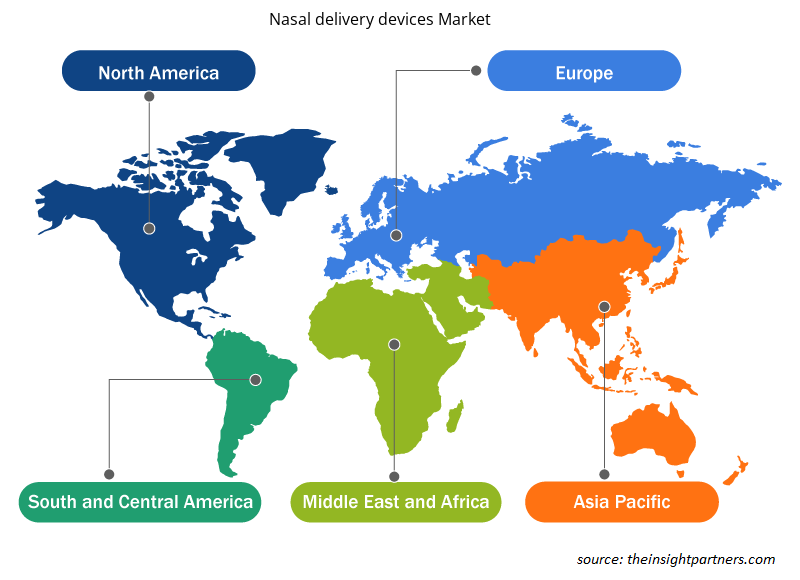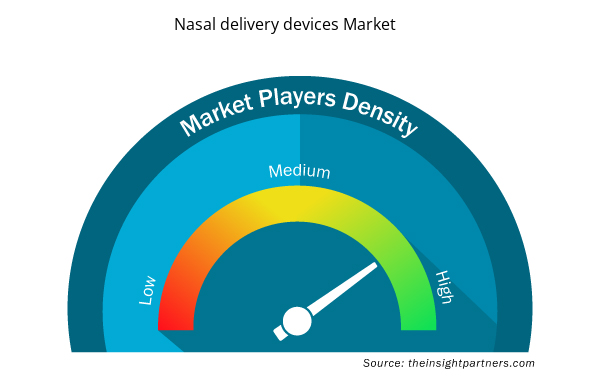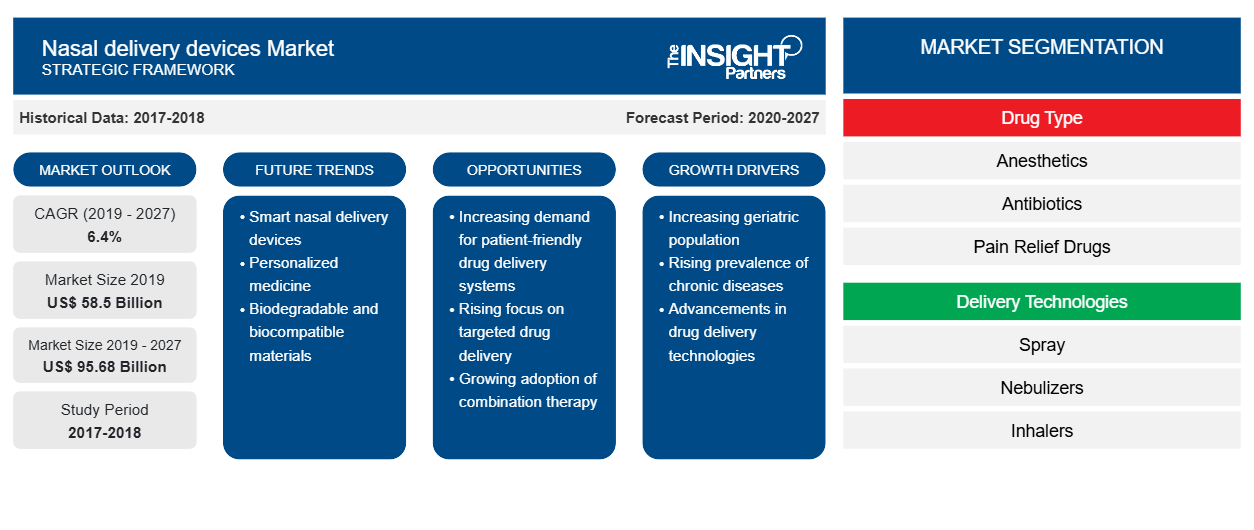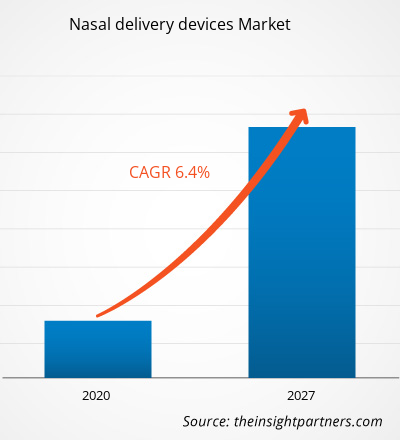鼻腔给药装置市场规模预计将从 2019 年的 585.0218 亿美元增至 2027 年的 956.7662 亿美元。预计 2020 年至 2027 年期间,该市场的复合年增长率为 6.4%。
鼻腔给药是患者和医疗保健提供者最喜欢的给药途径之一。这主要归因于这种给药途径的非侵入性以及通过鼻腔途径吸收药物的能力更强。此外,与胃肠道途径相比,鼻腔途径为药物提供了不太恶劣的环境,从而能够更好地吸收药物。这些药物的易用性在提高患者对药物治疗的依从性方面起着至关重要的作用,从而推动了患者的治疗效果。考虑到这些因素,患者和医疗保健提供者对鼻腔给药的偏好正在增加。鼻腔血管丰富,可增强药物吸收,从而快速起效。世界卫生组织 (WHO) 为制造商提供了具体的指导方针,概述了采用具有一次性给药系统的新型鼻腔给药装置的所有必要要求。因此,与其他给药途径不同,鼻腔给药不需要严格的无菌方法将药物注入体内。因此,由于患者和医疗保健提供者对鼻腔给药益处的认识不断提高,对鼻腔给药的偏好不断提高,从而推动了市场的增长。
定制此报告以满足您的需求
您可以免费定制任何报告,包括本报告的部分内容、国家级分析、Excel 数据包,以及为初创企业和大学提供优惠和折扣
- 获取此报告的关键市场趋势。这个免费样品将包括数据分析,从市场趋势到估计和预测。
市场洞察
呼吸系统和中枢神经系统疾病患病率不断上升
使用新型鼻腔给药装置的初步概念验证研究显示,该装置在治疗呼吸系统疾病、神经系统疾病和其他疾病方面取得了良好的效果。给药装置在确保将全部药物输送到鼻腔目标部位方面发挥着重要作用。在过去的几十年里,已经引入了几种创新的药物输送方法,这些方法可能克服了穿越血脑屏障 (BBB) 的挑战。几项科学研究支持这样的推测:通过鼻腔途径输送药物可能会使更高浓度的药物穿过血脑屏障。神经系统疾病发病率的上升将增加对鼻腔给药装置的需求。根据美国临床肿瘤学会 (ASCO) 的数据,2020 年,美国 0-14 岁年龄段的儿童中诊断出约 3,540 例脑肿瘤和其他中枢神经系统肿瘤。该报告还指出,脑肿瘤和其他中枢神经系统肿瘤是儿童中第二大常见癌症,占 15 岁以下儿童癌症病例的约 26%。
急性下呼吸道感染、肺结核、慢性阻塞性肺病(COPD,包括支气管炎和肺气肿在内的一种疾病)、哮喘和肺癌等呼吸系统疾病是全球范围内导致严重疾病和死亡的最常见原因。日益严重的城市化和污染、不健康的生活方式和习惯以及吸烟率高是导致呼吸系统和心血管疾病病例激增的因素之一。呼吸系统疾病可导致急性呼吸衰竭,治疗需要通过鼻腔给药进行持续支持。根据全球哮喘网络发布的《2018 年全球哮喘报告》,全球约有 3.3 亿人患有哮喘。此外,根据卫生指标与评估研究所的一项特别研究项目《全球疾病负担》的估计,2016 年,约有 42 万人死于哮喘。根据美国国家医学图书馆和国立卫生研究院 2018 年发表的一项研究,韩国哮喘的发病率一直很高,尤其是在女性和老年人群中。此外,根据全球疾病负担研究报告,2016 年 COPD 病例的患病率为 2.51 亿。超过 90% 的 COPD 死亡发生在中低收入国家 (LMIC),该疾病很可能在未来 15 年成为世界主要死亡原因。
因此,呼吸系统疾病、神经系统疾病和其他慢性疾病的发病率不断上升,推动了对鼻腔给药装置的需求,以便在目标部位有效给药。
药物类型洞察
根据药物类型,鼻腔给药装置市场分为麻醉药、抗生素、止痛药、钙补充剂、血管收缩剂、抗组胺药等。2019 年,抗组胺药占据了最大的市场份额。该细分市场的增长归因于过敏性鼻炎的增加。
交付技术洞察
根据给药技术,全球鼻腔给药设备市场分为喷雾器、雾化器、吸入器等。2019 年,吸入器占据了市场的大部分份额,预计在预测期内将实现市场最高复合年增长率。
最终用户洞察
根据最终用户,全球鼻腔给药设备市场分为家庭护理环境、医院和诊所。2019 年,家庭护理环境占据了大部分市场份额,预计在预测期内将实现最高的复合年增长率。
产品发布和审批是公司扩大全球业务范围和产品组合以满足日益增长的消费者需求的常用策略。鼻腔给药设备市场参与者采用合作策略来扩大全球客户群,这也使他们能够在全球范围内维护自己的品牌名称。
鼻腔给药装置市场区域洞察
Insight Partners 的分析师已详尽解释了预测期内影响鼻腔给药装置市场的区域趋势和因素。本节还讨论了北美、欧洲、亚太地区、中东和非洲以及南美和中美洲的鼻腔给药装置市场细分和地理位置。

- 获取鼻腔输送装置市场的区域特定数据
鼻腔给药装置市场报告范围
| 报告属性 | 细节 |
|---|---|
| 2019 年市场规模 | 585亿美元 |
| 2027 年市场规模 | 956.8亿美元 |
| 全球复合年增长率(2019 - 2027) | 6.4% |
| 史料 | 2017-2018 |
| 预测期 | 2020-2027 |
| 涵盖的领域 | 按药物类型
|
| 覆盖地区和国家 | 北美
|
| 市场领导者和主要公司简介 |
|
鼻腔给药装置市场参与者密度:了解其对业务动态的影响
鼻腔给药设备市场正在快速增长,这得益于终端用户需求的不断增长,这些需求源于消费者偏好的不断变化、技术进步以及对产品优势的认识不断提高等因素。随着需求的增加,企业正在扩大其产品范围,进行创新以满足消费者的需求,并利用新兴趋势,从而进一步推动市场增长。
市场参与者密度是指在特定市场或行业内运营的企业或公司的分布情况。它表明在给定市场空间中,相对于其规模或总市场价值,有多少竞争对手(市场参与者)存在。
在鼻腔给药装置市场运营的主要公司有:
- 葛兰素史克公司
- 阿斯利康
- 辉瑞公司
- 屋宇署
- 赛诺菲
免责声明:上面列出的公司没有按照任何特定顺序排列。

- 获取鼻腔给药装置市场顶级关键参与者概览
鼻腔给药装置市场 – 按药物类型
- 麻醉药
- 抗生素
- 止痛药
- 钙补充剂
- 血管收缩剂
- 抗组胺药
- 其他的
鼻腔给药设备市场 – 按给药技术分类
- 喷
- 雾化器
- 吸入器
- 其他的
鼻腔给药装置市场 – 按最终用户划分
- 家庭护理设置
- 医院
- 诊所
鼻腔给药设备市场 – 按地区划分
- 北美
- 我们
- 加拿大
- 墨西哥
- 欧洲
- 法国
- 德国
- 意大利
- 英国
- 西班牙
- 欧洲其他地区
- 亚太地区 (APAC)
- 中国
- 印度
- 韩国
- 日本
- 澳大利亚
- 亚太其他地区
- 中东和非洲 (MEA)
- 南非
- 沙特阿拉伯
- 阿联酋
- 中东和非洲其他地区
- 南美洲和中美洲
- 巴西
- 阿根廷
- 南美洲其他地区
公司简介
- 葛兰素史克公司
- 阿斯利康
- 辉瑞公司
- 屋宇署
- 赛诺菲
- 默克公司
- 卡迪拉制药有限公司
- 诺华公司
- 雷迪博士实验室
- Neurelis 公司
- 历史分析(2 年)、基准年、预测(7 年)及复合年增长率
- PEST 和 SWOT 分析
- 市场规模价值/数量 - 全球、区域、国家
- 行业和竞争格局
- Excel 数据集



Report Coverage
Revenue forecast, Company Analysis, Industry landscape, Growth factors, and Trends

Segment Covered
This text is related
to segments covered.

Regional Scope
North America, Europe, Asia Pacific, Middle East & Africa, South & Central America

Country Scope
This text is related
to country scope.
常见问题
The nasal delivery devices market majorly consists of the players such as GlaxoSmithKline plc.,AstraZeneca, Pfizer Inc., BD, Sanofi, Merck & Co., Inc., Cadila Pharmaceuticals Ltd., Novartis AG, Dr. Reddy's Laboratories, and Neurelis. amongst others.
The factors that are driving growth of the market are growing prevalence of respiratory and cns diseases and increasing preference and awareness of intranasal drug delivery among patients.Moreover, strategic activities by the manufacturersare offering lucrative opportunities for the growth of the market.
Nasal drug delivery is one of the efficient route of drug administration. It offers needle-free drug delivery, optimal route for brain-targeted therapies, and superior bioavailability. Nasal route of administration is preferred in several disease indications such as Parkinson’s disease, prostate cancer, migraine, and influenza amongst others. Moreover, nasal route is also suitable for the treatment of drug addiction as well as for sedation.
Trends and growth analysis reports related to Life Sciences : READ MORE..
The List of Companies - Nasal delivery devices Market
- GlaxoSmithKline plc.
- AstraZeneca
- Pfizer Inc.
- BD
- Sanofi
- Merck & Co., Inc.
- Cadila Pharmaceuticals Ltd.
- Novartis AG
- Dr. Reddy's Laboratories
- Neurelis, Inc.
The Insight Partners performs research in 4 major stages: Data Collection & Secondary Research, Primary Research, Data Analysis and Data Triangulation & Final Review.
- Data Collection and Secondary Research:
As a market research and consulting firm operating from a decade, we have published and advised several client across the globe. First step for any study will start with an assessment of currently available data and insights from existing reports. Further, historical and current market information is collected from Investor Presentations, Annual Reports, SEC Filings, etc., and other information related to company’s performance and market positioning are gathered from Paid Databases (Factiva, Hoovers, and Reuters) and various other publications available in public domain.
Several associations trade associates, technical forums, institutes, societies and organization are accessed to gain technical as well as market related insights through their publications such as research papers, blogs and press releases related to the studies are referred to get cues about the market. Further, white papers, journals, magazines, and other news articles published in last 3 years are scrutinized and analyzed to understand the current market trends.
- Primary Research:
The primarily interview analysis comprise of data obtained from industry participants interview and answers to survey questions gathered by in-house primary team.
For primary research, interviews are conducted with industry experts/CEOs/Marketing Managers/VPs/Subject Matter Experts from both demand and supply side to get a 360-degree view of the market. The primary team conducts several interviews based on the complexity of the markets to understand the various market trends and dynamics which makes research more credible and precise.
A typical research interview fulfils the following functions:
- Provides first-hand information on the market size, market trends, growth trends, competitive landscape, and outlook
- Validates and strengthens in-house secondary research findings
- Develops the analysis team’s expertise and market understanding
Primary research involves email interactions and telephone interviews for each market, category, segment, and sub-segment across geographies. The participants who typically take part in such a process include, but are not limited to:
- Industry participants: VPs, business development managers, market intelligence managers and national sales managers
- Outside experts: Valuation experts, research analysts and key opinion leaders specializing in the electronics and semiconductor industry.
Below is the breakup of our primary respondents by company, designation, and region:

Once we receive the confirmation from primary research sources or primary respondents, we finalize the base year market estimation and forecast the data as per the macroeconomic and microeconomic factors assessed during data collection.
- Data Analysis:
Once data is validated through both secondary as well as primary respondents, we finalize the market estimations by hypothesis formulation and factor analysis at regional and country level.
- Macro-Economic Factor Analysis:
We analyse macroeconomic indicators such the gross domestic product (GDP), increase in the demand for goods and services across industries, technological advancement, regional economic growth, governmental policies, the influence of COVID-19, PEST analysis, and other aspects. This analysis aids in setting benchmarks for various nations/regions and approximating market splits. Additionally, the general trend of the aforementioned components aid in determining the market's development possibilities.
- Country Level Data:
Various factors that are especially aligned to the country are taken into account to determine the market size for a certain area and country, including the presence of vendors, such as headquarters and offices, the country's GDP, demand patterns, and industry growth. To comprehend the market dynamics for the nation, a number of growth variables, inhibitors, application areas, and current market trends are researched. The aforementioned elements aid in determining the country's overall market's growth potential.
- Company Profile:
The “Table of Contents” is formulated by listing and analyzing more than 25 - 30 companies operating in the market ecosystem across geographies. However, we profile only 10 companies as a standard practice in our syndicate reports. These 10 companies comprise leading, emerging, and regional players. Nonetheless, our analysis is not restricted to the 10 listed companies, we also analyze other companies present in the market to develop a holistic view and understand the prevailing trends. The “Company Profiles” section in the report covers key facts, business description, products & services, financial information, SWOT analysis, and key developments. The financial information presented is extracted from the annual reports and official documents of the publicly listed companies. Upon collecting the information for the sections of respective companies, we verify them via various primary sources and then compile the data in respective company profiles. The company level information helps us in deriving the base number as well as in forecasting the market size.
- Developing Base Number:
Aggregation of sales statistics (2020-2022) and macro-economic factor, and other secondary and primary research insights are utilized to arrive at base number and related market shares for 2022. The data gaps are identified in this step and relevant market data is analyzed, collected from paid primary interviews or databases. On finalizing the base year market size, forecasts are developed on the basis of macro-economic, industry and market growth factors and company level analysis.
- Data Triangulation and Final Review:
The market findings and base year market size calculations are validated from supply as well as demand side. Demand side validations are based on macro-economic factor analysis and benchmarks for respective regions and countries. In case of supply side validations, revenues of major companies are estimated (in case not available) based on industry benchmark, approximate number of employees, product portfolio, and primary interviews revenues are gathered. Further revenue from target product/service segment is assessed to avoid overshooting of market statistics. In case of heavy deviations between supply and demand side values, all thes steps are repeated to achieve synchronization.
We follow an iterative model, wherein we share our research findings with Subject Matter Experts (SME’s) and Key Opinion Leaders (KOLs) until consensus view of the market is not formulated – this model negates any drastic deviation in the opinions of experts. Only validated and universally acceptable research findings are quoted in our reports.
We have important check points that we use to validate our research findings – which we call – data triangulation, where we validate the information, we generate from secondary sources with primary interviews and then we re-validate with our internal data bases and Subject matter experts. This comprehensive model enables us to deliver high quality, reliable data in shortest possible time.


 获取此报告的免费样本
获取此报告的免费样本